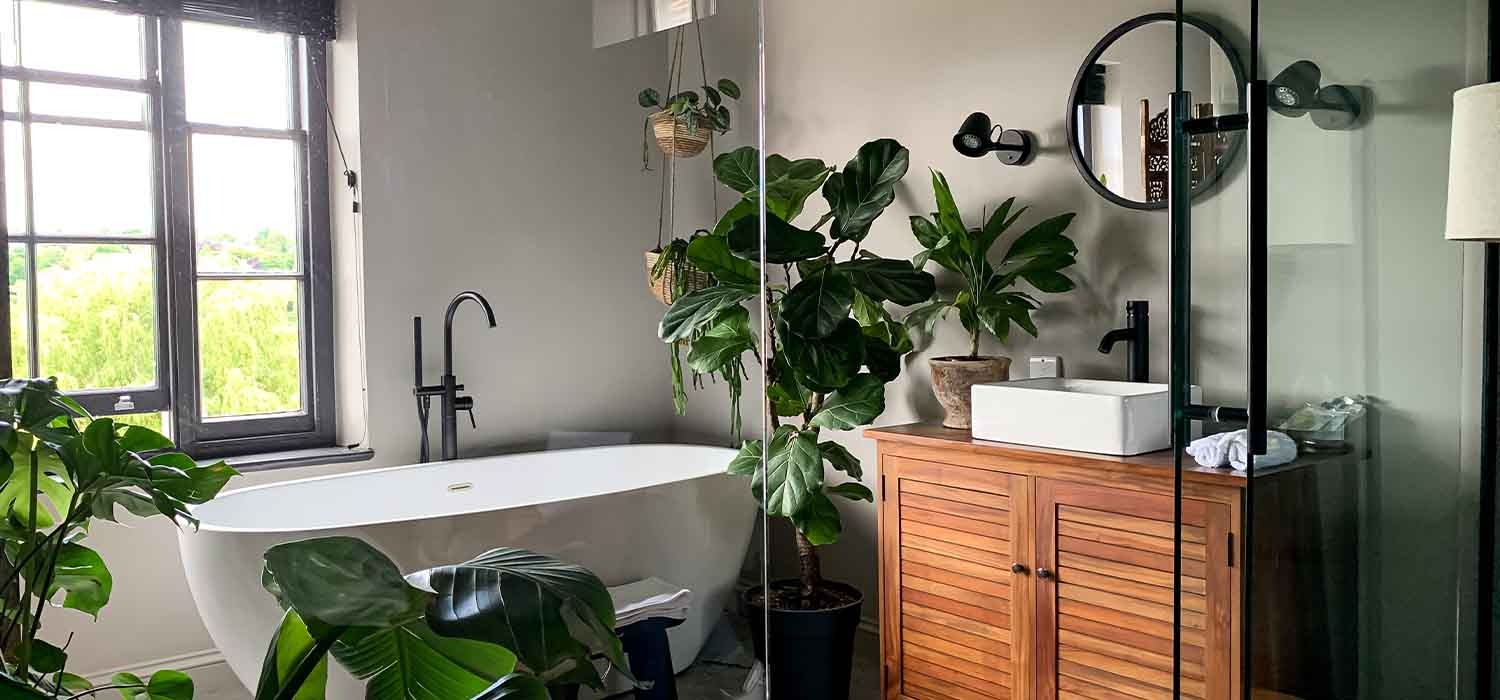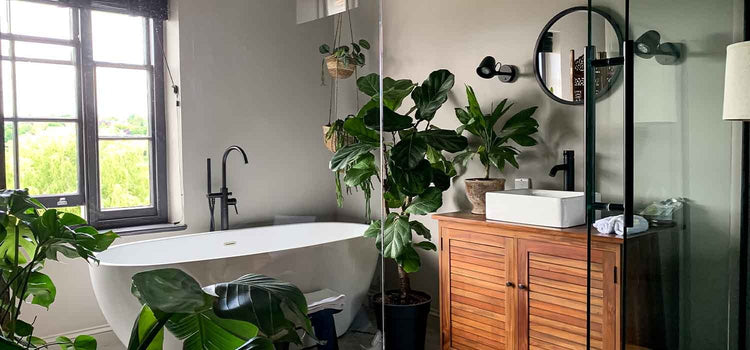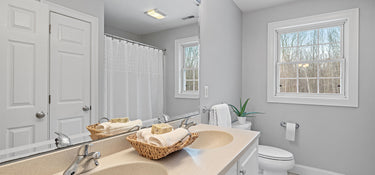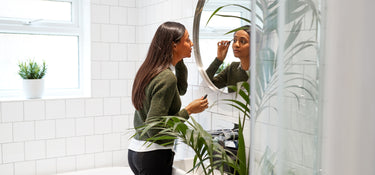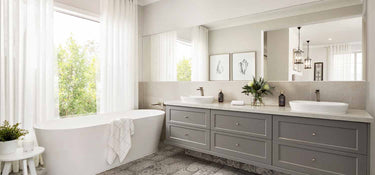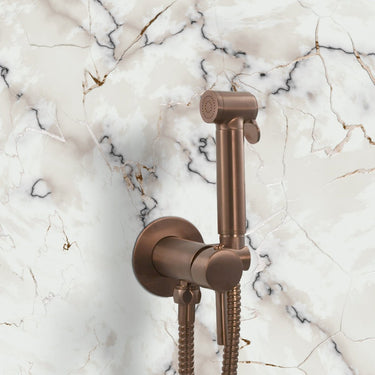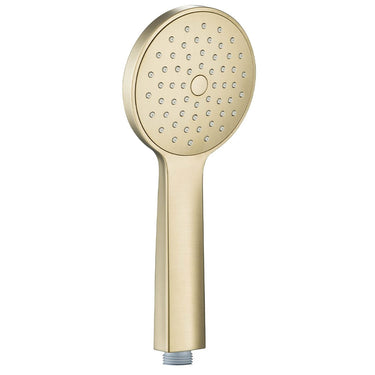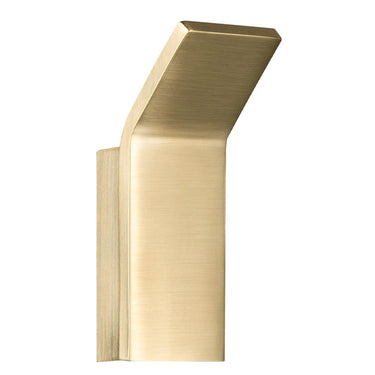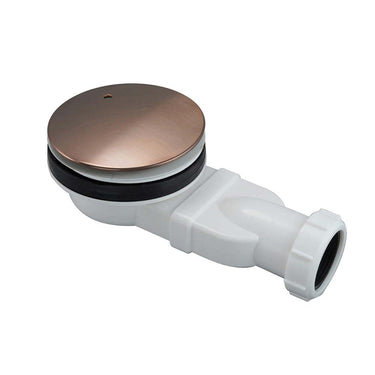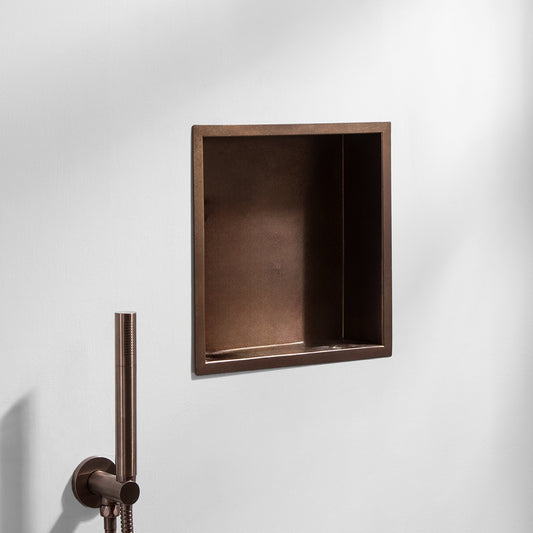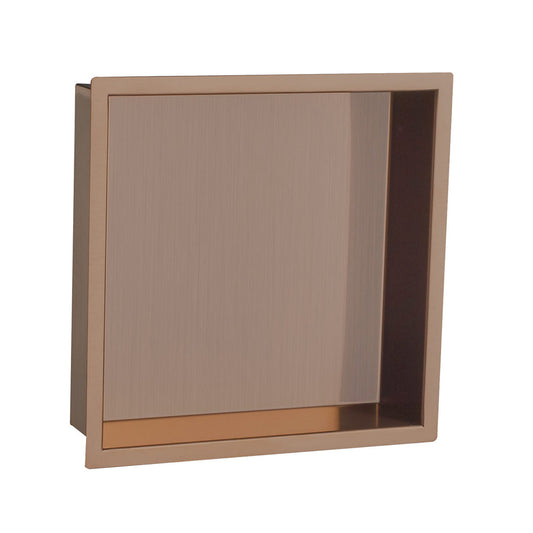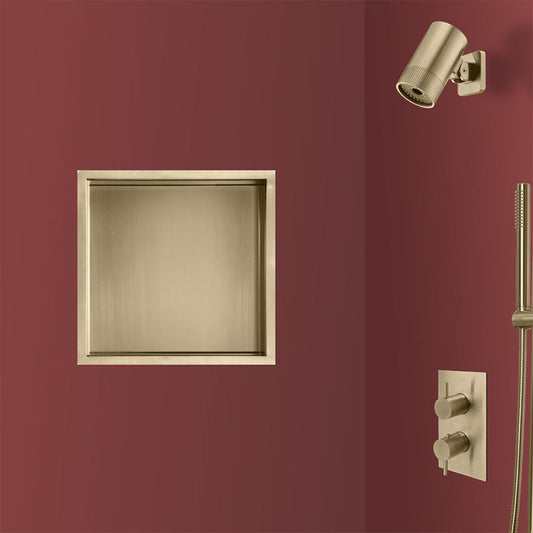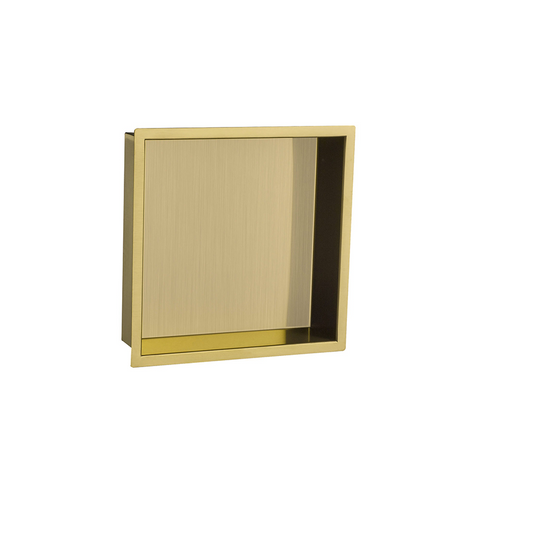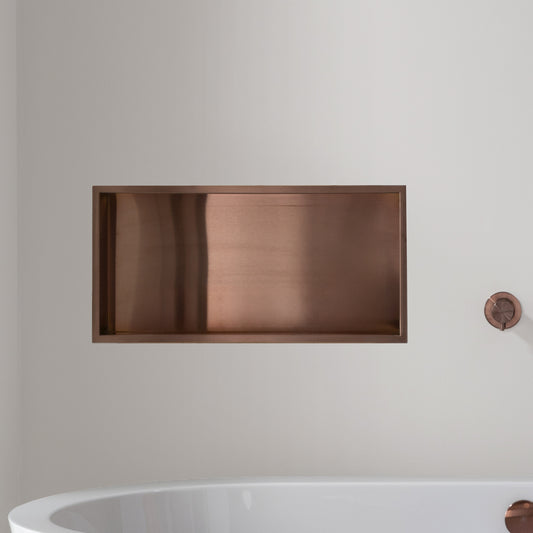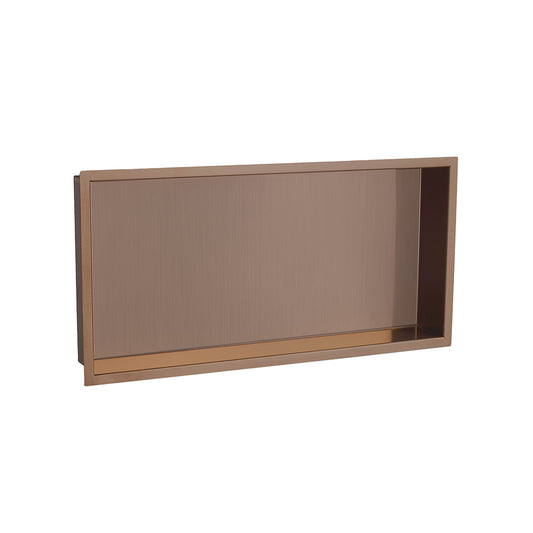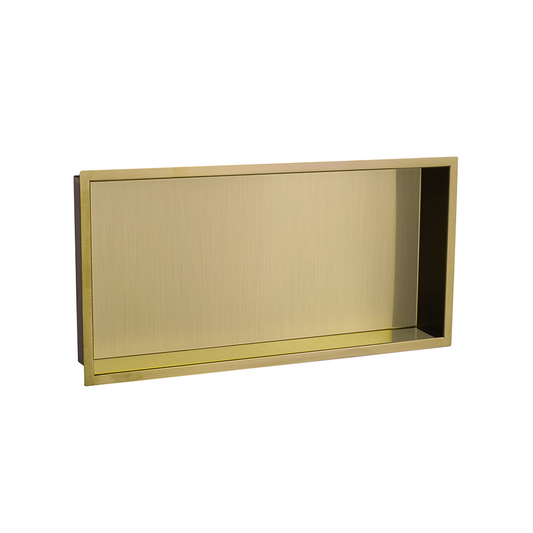The Best Bathroom Plants for Your Sanctuary: Top Picks for a Relaxing Retreat
Table Of Contents:
-
Introduction
→ -
Shower Accessories Collection
→ -
Why Add Plants to Your Bathroom?
→ -
Top Bathroom Plants to Enhance Your Sanctuary
→ -
Best Plants for Bathrooms Without Windows
→ -
Best Plants for Small Bathrooms
→ -
Best Plants for Large Bathrooms
→ -
Tips for Caring for Bathroom Plants
→ -
Creative Alternatives to Real Plants for Your Bathroom
→ -
How to Choose Bathroom Plants: A Guide to Selecting the Right Greenery
→ -
How to Style Bathroom Plants: Creative Ways to Integrate Greenery into Your Space
→ -
Conclusion
→ -
FAQs
→
Introduction
Creating a sanctuary in your bathroom goes beyond just installing stylish fixtures and luxurious towels. Plants are a powerful way to elevate the ambiance, bringing nature’s tranquility into this private space. However, because bathrooms typically have higher humidity and lower light levels than other rooms, choosing the right plants is essential. In this expanded guide, we’ll explore the best bathroom plants for every type of bathroom, from small and windowless to spacious ones with abundant natural light. Plus, we’ll provide you with essential care tips and placement recommendations to help your bathroom garden thrive.
Why Add Plants to Your Bathroom?
There are countless benefits to introducing plants into your bathroom beyond aesthetics. The right plants can significantly enhance the overall environment and atmosphere of the space:
Improved Air Quality:
Plants have the remarkable ability to purify the air by absorbing toxins and releasing oxygen. Bathroom plants, such as Peace Lilies and Spider Plants, can help remove harmful chemicals like formaldehyde, benzene, and xylene from the air, which may be present in cleaning products, paints, or bathroom materials. By boosting oxygen levels and filtering the air, plants make the bathroom feel fresher and healthier.
Humidity Control:
Bathrooms are naturally humid spaces, making them the perfect environment for moisture-loving plants. Some plants, like the Fern or the Boston Fern, thrive in humidity and help regulate the moisture levels in the room. This helps prevent mold growth and keeps the air in your bathroom feeling balanced.
Relaxing Atmosphere:
The visual appeal of plants has been shown to reduce stress and improve mental well-being. Introducing greenery into your bathroom, especially with plants known for their soothing properties, can create a calming, spa-like atmosphere that helps you unwind. The simple act of watering and caring for plants can also be a mindfulness practice, helping you relax and focus on the present moment.
Natural Aesthetic:
A plant or two in the bathroom can dramatically enhance the overall decor. Whether you have a modern minimalist bathroom or a vintage-inspired design, the natural beauty of plants complements a wide range of styles. Plants also help introduce organic textures and colors that balance out sleek tiles, marble counters, and other more clinical materials, giving the space a homier, more inviting feel.
Top Bathroom Plants to Enhance Your Sanctuary
Transforming your bathroom into a calming and refreshing sanctuary is easier than you think with the right choice of plants. Whether you're working with a bathroom that gets ample sunlight, is dimly lit, or even lacks windows altogether, there are plants that will thrive in every type of environment. Here's a breakdown of the best bathroom plants for various spaces, each with unique characteristics to suit your bathroom's conditions.

1. ZZ Plant (Zamioculcas zamiifolia) – Perfect for Low-Light Spaces
The ZZ plant is an excellent choice for bathrooms that receive little to no natural light. This plant’s striking, glossy, dark green leaves add sophistication and shine, making it a sleek addition to any bathroom decor. The ZZ plant is known for its resilience and low-maintenance care, making it perfect for both beginner and experienced plant owners. It’s also a natural air purifier, filtering out toxins from the air, which is an added bonus in a space that is frequently used for personal care routines.
Ideal Conditions:
- Light: The ZZ plant thrives in low to medium light. It can survive in dark bathrooms, but indirect light will encourage healthier growth.
- Humidity: The ZZ plant is not particularly fussy about humidity, making it a versatile choice for both dry and moderately humid spaces.
- Watering: Allow the soil to dry out completely between waterings. Overwatering can lead to root rot, so it’s best to err on the side of too little water rather than too much.
Care Tip: While the ZZ plant can survive with little care, it's crucial to let the soil dry out thoroughly between waterings. Avoid placing it in direct sunlight, as it can cause the leaves to scorch.
2. Maidenhair Fern (Adiantum) – Add a Tropical Touch
If you're looking for a tropical vibe in your bathroom, the Maidenhair Fern is a beautiful and elegant choice. Known for its delicate, feathery fronds, this fern brings an exotic touch to any bathroom. It thrives in the high humidity often found in bathrooms and does best in bright, indirect light. The Maidenhair Fern is ideal for bathrooms with a shower or bathtub, as it loves the moisture and warmth of a humid environment.
Ideal Conditions:
- Light: Maidenhair ferns do best in bright, indirect light. Too much direct sunlight can burn the fronds, while too little light can stunt their growth.
- Humidity: This plant thrives in the humid conditions of a bathroom, so it's perfect for areas with high moisture levels.
- Watering: Keep the soil consistently moist, but avoid waterlogging, as this can lead to root rot. Be sure to allow for proper drainage.
Care Tip: Maidenhair ferns require regular moisture but are sensitive to overwatering. Make sure the soil has good drainage, and consider placing the fern in a bathroom corner with bright, indirect light to keep its fronds lush and healthy.
3. Bromeliad (Bromeliaceae) – Vibrant Color for Your Bathroom
Bromeliads are a fantastic option for adding color and vibrancy to your bathroom. Known for their spiky foliage and brightly colored flowers, which come in hues like red, pink, and yellow, Bromeliads can become a statement piece in your bathroom decor. These plants thrive in the humid environment of a bathroom and are particularly suited for spaces near the shower or bathtub.
Ideal Conditions:
- Light: Bromeliads prefer bright, indirect light but can tolerate lower light conditions as well.
- Humidity: These plants thrive in high humidity, making them a perfect fit for bathrooms.
- Watering: Water the central cup of the plant regularly, but ensure that the soil dries out between waterings to prevent rot.
Care Tip: Change the water in the central cup every few days to prevent stagnation and bacterial growth. Water the soil lightly and allow it to dry out between waterings to keep the plant healthy.

4. Cactus (Cactaceae) – For Sunlit Bathrooms
If your bathroom gets plenty of natural light, a small cactus can be a charming and quirky addition. Cacti thrive in bright, direct sunlight and are well-suited to bathrooms with windowsills or areas with abundant sun. Cacti are incredibly low-maintenance, requiring very little water and almost no attention, which makes them perfect for those who want to add a touch of greenery without the fuss.
Ideal Conditions:
- Light: Cacti need bright, direct light to thrive, making them ideal for bathrooms with lots of natural sunlight.
- Humidity: Cacti do best in dry conditions, so avoid placing them in areas with high humidity.
- Watering: Water sparingly and allow the soil to dry completely between waterings. Cacti are drought-tolerant and can survive with minimal moisture.
Care Tip: Make sure to water your cactus only when the soil is completely dry. Overwatering can cause the plant to rot, so be sure not to water too frequently.
5. Coleus (Plectranthus scutellarioides) – Bold Colors for a Cozy Bathroom
Coleus is a striking plant with vibrant, patterned leaves in shades of purple, red, and green. Its colorful foliage can add a lively pop to any bathroom, and it thrives in humid conditions. This plant is perfect for creating a cozy and welcoming bathroom space. While it prefers bright, indirect light, it can also tolerate moderate light levels, making it adaptable to various bathroom environments.
Ideal Conditions:
- Light: Coleus thrives in bright, indirect light but can tolerate moderate light levels.
- Humidity: It enjoys high humidity, making it a great fit for most bathrooms.
- Watering: Keep the soil consistently moist but not soggy. Regular watering is essential to keep the plant vibrant.
Care Tip: Trim Coleus regularly to prevent it from becoming leggy. It also benefits from periodic pruning, which will help keep it compact and encourage new growth.
6. Calathea (Calathea spp.) – Patterns and Texture for Your Bathroom
Calatheas are known for their decorative, patterned leaves that can add a touch of artistry to your bathroom. With varieties featuring intricate stripes, spots, and bold colors, these plants can become an eye-catching focal point. They thrive in the humid environment of a bathroom and require indirect light to keep their leaves vibrant and healthy.
Ideal Conditions:
- Light: Calatheas prefer bright, indirect light but will also tolerate low light. Too much direct sunlight can scorch their leaves.
- Humidity: High humidity is ideal for Calatheas, making bathrooms with showers or bathtubs a perfect location.
- Watering: Keep the soil consistently moist, and avoid letting the soil dry out completely.
Care Tip: Regular misting can help maintain the humidity levels that Calatheas love. Make sure to water them with lukewarm water and avoid wetting the leaves directly to prevent water spots.

7. English Ivy (Hedera helix) – Elegant and Easy to Grow
English Ivy is an elegant, versatile plant that can add a sense of sophistication to any bathroom. This plant is perfect for training to climb or cascade down walls, creating a dramatic effect. English Ivy thrives in humid environments and can tolerate a wide range of light conditions, making it a great option for bathrooms with moderate to low light.
Ideal Conditions:
- Light: While English Ivy can adapt to lower light levels, it performs best in moderate light.
- Humidity: It thrives in humid conditions, making it ideal for bathrooms with fluctuating moisture levels.
- Watering: Keep the soil consistently moist but not soggy. Water when the top inch of soil feels dry.
Care Tip: English Ivy benefits from occasional pruning to keep it tidy and encourage new growth. Trim back any overly long or leggy vines to maintain its shape.
8. African Violet (Saintpaulia) – Compact Beauty for Small Spaces
African Violets are the perfect solution for small bathrooms looking to add color and beauty without overwhelming the space. Their compact size and vibrant flowers, which bloom in shades of purple, pink, or white, make them ideal for tight corners or shelves. African Violets thrive in moderate humidity and low to medium light, making them adaptable to various bathroom conditions.
Ideal Conditions:
- Light: African Violets do best in bright, indirect light but can tolerate low light conditions.
- Humidity: They enjoy moderate humidity levels, making bathrooms a great environment for them.
- Watering: Keep the soil moist but avoid watering directly onto the leaves to prevent damage.
Care Tip: Water African Violets from the bottom by placing the pot in a saucer of water, allowing the plant to soak up moisture. This helps avoid wetting the delicate leaves.
9. Golden Pothos (Epipremnum aureum) – Trailing Vines for Vertical Interest
Golden Pothos is a popular, fast-growing vine that can easily be trained to trail down from shelves, hang in baskets, or climb up a trellis. This versatile plant is well-suited to bathrooms with high humidity and can adapt to a wide range of lighting conditions. Its attractive, heart-shaped leaves add a lush, tropical feel to any bathroom.
Ideal Conditions:
- Light: Golden Pothos thrives in indirect light but can tolerate lower light levels as well.
- Humidity: This plant loves humidity, making it perfect for bathrooms with regular moisture.
- Watering: Water when the top inch of soil feels dry. Golden Pothos is relatively drought-tolerant, so it's better to underwater than overwater.
Care Tip: Prune the plant regularly to prevent it from becoming too long or unruly. It also benefits from occasional trimming to encourage fuller growth.
10. Begonia (Begonia spp.) – A Splash of Color and Texture
Begonias are known for their striking, waxy leaves and occasional colorful blooms. These plants are ideal for adding texture and visual interest to a bathroom. They thrive in moderate humidity and low to medium light, making them adaptable to many bathroom environments.
Ideal Conditions:
- Light: Begonias prefer bright, indirect light. Avoid direct sunlight, as it can scorch their leaves.
- Humidity: Begonias thrive in bathrooms with high humidity.
- Watering: Keep the soil moist but well-drained to prevent overwatering.
Care Tip: Be careful not to overwater your Begonia, as this can lead to root rot. Ensure the pot has good drainage and water only when the top inch of soil is dry.
Best Plants for Bathrooms Without Windows
Bathrooms without windows can present a challenge when it comes to plant care, as natural light is limited or non-existent. However, certain plants are well-suited for these low-light environments and can thrive even without direct sunlight. These plants are incredibly adaptable and can add a lush, vibrant touch to windowless bathrooms, helping to transform them into relaxing, green retreats. Below are some excellent plant choices for bathrooms without windows that can survive and even thrive in low-light conditions.

1. Snake Plant (Sansevieria trifasciata) – Hardy and Air-Purifying
The Snake Plant, also known as Mother-in-Law's Tongue, is one of the most popular plants for low-light environments, making it an ideal choice for windowless bathrooms. Its striking upright leaves with green and yellow variegated patterns make it a beautiful addition to any bathroom decor. This plant is also extremely low-maintenance, requiring very little attention to thrive. In fact, the Snake Plant is known for its air-purifying properties, as it can filter out toxins like formaldehyde and benzene from the air.
Snake plants are perfect for windowless bathrooms because they can survive in low light and don't need to be watered frequently. In addition to being aesthetically pleasing, they help improve the indoor air quality, making your bathroom not only greener but also healthier.
Ideal Conditions:
- Light: Snake plants can thrive in extremely low light conditions and can tolerate direct sunlight, although they prefer indirect light. They will do well even in dark spaces with minimal natural light.
- Humidity: They can adapt to the humidity levels found in bathrooms, but they do prefer dry air over overly damp conditions.
- Watering: Snake plants require minimal watering. Allow the soil to dry out completely between waterings, as overwatering can lead to root rot.
Care Tip: Snake plants can handle neglect, but make sure not to overwater them. They prefer a dry environment, so let the soil dry completely before watering again. Keep them in a cool, low-light area to see them flourish.
2. Cast Iron Plant (Aspidistra elatior) – Low-Light Tolerant
As its name suggests, the Cast Iron plant is tough and resilient, making it perfect for spaces with limited natural light, such as windowless bathrooms. This plant is known for its hardy nature, able to tolerate neglect and thrive in less-than-ideal conditions. The Cast Iron plant has dark green, glossy leaves that give it a sleek, elegant appearance, making it a popular choice for modern and minimalist bathroom decor.
The Cast Iron plant does well in low-light conditions and can survive in bathrooms where there is no direct sunlight. It is also highly resistant to common plant problems like pests or disease, making it a reliable option for anyone looking to add some greenery to a space with little natural light.
Ideal Conditions:
- Light: The Cast Iron plant thrives in low to medium light, making it well-suited for windowless bathrooms. While it can tolerate brighter spots, it does best in dark corners where natural light is scarce.
- Humidity: It thrives in the humidity of bathrooms but can also handle drier conditions without too much stress.
- Watering: This plant is drought-tolerant and can go without water for a while. Water it when the top inch of soil feels dry, but avoid overwatering.
Care Tip: While the Cast Iron plant can withstand neglect, it is important to avoid overwatering. Ensure the soil is well-drained and allow it to dry out before the next watering. This will prevent root rot and ensure the plant remains healthy in your bathroom.

3. Chinese Evergreen (Aglaonema) – Beautiful and Easy to Care For
The Chinese Evergreen is another excellent choice for low-light environments, making it perfect for windowless bathrooms. Known for its beautiful, variegated foliage, which comes in shades of green, silver, and red, the Chinese Evergreen adds a splash of color and visual interest to any space. This plant is not only decorative but also an excellent air purifier, helping to remove toxins and improve the air quality in your bathroom.
Chinese Evergreens are relatively easy to care for, making them a great option for people who may not have a green thumb. They can adapt to both low light and higher humidity levels, which are common in bathrooms. Additionally, the Chinese Evergreen is known for its resilience, making it a great choice for less ideal spaces where natural light is limited.
Ideal Conditions:
- Light: Chinese Evergreens are perfect for low-light environments and can thrive in areas with minimal natural light. While they can tolerate medium light, they are not suited for direct sunlight.
- Humidity: This plant enjoys the humid atmosphere of bathrooms and can tolerate higher moisture levels. It does well in the typical bathroom humidity without being overly fussy.
- Watering: Keep the soil consistently moist but not waterlogged. Allow the top inch of soil to dry out between waterings to avoid overwatering.
Care Tip: Chinese Evergreens prefer slightly moist soil, but avoid letting the plant sit in water. They will thrive in bathrooms with moderate humidity, but be cautious not to overwater, as this can cause root rot.
Best Plants for Small Bathrooms
Small bathrooms often present a challenge when it comes to selecting plants, as you want to choose ones that won’t overcrowd the space while still contributing to the room’s atmosphere. When selecting plants for small bathrooms, it’s important to find species that thrive in the typical bathroom conditions—high humidity, low or indirect light, and often limited space. Below are some excellent plant options that will not only fit your bathroom’s dimensions but also add beauty and functionality to the room.

1. Aloe Vera – Compact and Medicinal
Aloe Vera is an excellent choice for small bathrooms, offering both practical and aesthetic benefits. Known for its healing properties, Aloe Vera can be used to soothe burns, cuts, and skin irritation, making it an especially useful plant to have on hand in your bathroom. Its thick, succulent leaves store moisture, which allows it to thrive in humid conditions—perfect for a bathroom environment.
Aloe Vera is also a visually appealing plant with long, spiky leaves that can grow in a compact rosette, making it ideal for tight spaces. It is a low-maintenance plant that doesn’t require much attention, which makes it perfect for busy households.
Ideal Conditions:
- Light: Aloe Vera prefers bright, indirect light but can tolerate some direct sunlight. If your bathroom has a window, this is a great place to position it.
- Humidity: Aloe Vera thrives in humidity but can also tolerate drier conditions. Its adaptability makes it a great plant for bathrooms that experience fluctuating moisture levels.
- Watering: Water sparingly, ensuring the soil is allowed to dry out between waterings. Aloe Vera is drought-tolerant and is prone to root rot if overwatered.
Care Tip: Aloe Vera is sensitive to overwatering, so it’s crucial to let the soil dry completely between waterings. Additionally, ensure that the pot has good drainage to prevent water from sitting at the bottom.
2. Prayer Plant (Maranta leuconeura) – Small and Stunning
The Prayer Plant is a small but striking option for smaller bathrooms. Its compact size and vibrant, intricate leaf patterns make it an attractive addition to any bathroom counter, shelf, or vanity. Known for its ability to move its leaves, the Prayer Plant has earned its name from its habit of folding its leaves upward in the evening, resembling hands in prayer.
Prayer Plants thrive in high humidity, which makes them perfectly suited for bathroom environments where moisture levels are higher than other rooms in the house. Additionally, they perform well in medium to low light conditions, making them versatile for bathrooms with limited natural light.
Ideal Conditions:
- Light: Prefers medium to low light. Avoid direct sunlight, as it can scorch the leaves.
- Humidity: Prayer Plants love high humidity, so they will thrive in bathrooms with frequent showers or baths. They’re perfect for environments that provide consistent moisture.
- Watering: Prayer plants thrive with consistent moisture. Keep the soil slightly moist at all times, but be sure not to let it become waterlogged.
Care Tip: Ensure the soil is moist but not soggy, as excessive moisture can lead to root rot. Mist the leaves regularly to maintain humidity levels around the plant, and keep the plant out of direct sunlight to prevent leaf burn.
Best Plants for Large Bathrooms
Larger bathrooms offer more flexibility when it comes to plant selection. You can opt for larger, more dramatic plants that fill the space and create a lush, tropical feel. These plants not only add visual interest but also thrive in the typically humid conditions found in bathrooms. Below are two excellent plant choices that are perfect for larger bathrooms, where they can truly shine and make a bold statement.

1. Fiddle Leaf Fig (Ficus lyrata) – Bold and Beautiful
The Fiddle Leaf Fig is one of the most popular plants for larger spaces, and it’s a fantastic choice for spacious bathrooms. With its broad, glossy leaves and striking appearance, this plant serves as a dramatic focal point that can elevate the aesthetic of your bathroom. The large size of the Fiddle Leaf Fig makes it ideal for corner placement or as an eye-catching feature next to a bathtub or large vanity.
Fiddle Leaf Figs prefer indirect light, so a large bathroom with a generous amount of natural light is the perfect environment for this plant. The humidity of the bathroom is an added bonus, as the Fiddle Leaf Fig thrives in moist air, making it a perfect fit for this type of room.
Ideal Conditions:
- Light: Fiddle Leaf Figs prefer bright, indirect light but can tolerate some filtered sunlight. They should not be exposed to direct sunlight for long periods, as it can scorch the leaves.
- Humidity: This plant thrives in the humidity typically found in bathrooms. It’s ideal for a bathroom with high moisture levels, as the plant naturally grows in tropical environments.
- Watering: Water the Fiddle Leaf Fig regularly, but be careful not to overwater. Let the top layer of soil dry out between waterings to prevent root rot.
Care Tip: Be sure to place the Fiddle Leaf Fig where it will get enough indirect sunlight to maintain its healthy growth. Also, keep an eye on its leaves for any brown edges, which can be a sign of too much direct sunlight or overwatering.

2. Rubber Plant (Ficus elastica) – Elegant and Thriving in Large Spaces
The Rubber Plant, also known as Ficus elastica, is another excellent choice for large bathrooms. Known for its elegant, glossy green leaves, the Rubber Plant can grow quite tall, making it an excellent option for filling corners or creating a lush, tropical atmosphere in your bathroom. With its easy-care nature and ability to adapt to different light conditions, the Rubber Plant can be a perfect addition to larger bathrooms where space allows for its full growth.
This plant thrives in indirect light and loves the humidity, which makes it well-suited to bathroom environments. The Rubber Plant also benefits from the warmth and moisture found in larger bathrooms, where it can grow steadily and even produce new leaves regularly.
Ideal Conditions:
- Light: Rubber Plants prefer bright, indirect light but can tolerate lower light conditions. However, they will grow best in locations with consistent access to indirect sunlight.
- Humidity: Like the Fiddle Leaf Fig, the Rubber Plant enjoys the moisture and humidity found in bathrooms. This makes it a low-maintenance option for bathrooms with high humidity.
- Watering: Water the Rubber Plant when the top inch or two of soil feels dry. It’s important to avoid overwatering, so allow the soil to dry out a bit between waterings.
Care Tip: Make sure the Rubber Plant has plenty of room to grow. In larger bathrooms, placing it near a window or in a well-lit corner will help it thrive. Additionally, it’s a good idea to dust the glossy leaves regularly to maintain their shine and allow the plant to breathe properly.
Tips for Caring for Bathroom Plants
Humidity: Bathrooms naturally provide a humid environment, but it’s essential to monitor how much moisture your plants are exposed to. Excessive moisture can lead to root rot. Be sure that the soil drains properly to prevent waterlogging.
Watering: Each plant has specific watering needs. Many bathroom plants, especially those that thrive in humidity, need their soil to be consistently moist but never soggy. Always ensure proper drainage to prevent overwatering.
Lighting: While bathroom plants generally tolerate low to medium light, you should still ensure they receive enough indirect light. If your bathroom has no windows or lacks natural light, consider investing in grow lights to supplement their needs.
Drainage: Always choose plant pots with drainage holes. Standing water can quickly lead to root rot, especially in bathrooms where moisture is abundant.
Cleaning: Plants in the bathroom tend to collect dust and moisture. Wipe the leaves gently with a damp cloth regularly to keep your plants looking vibrant and healthy.
Creative Alternatives to Real Plants for Your Bathroom
If you're looking to bring nature into your bathroom without the hassle of maintaining real plants, there are plenty of creative alternatives that can still create a fresh, green ambiance. Here are some of the best options to consider:

1. Artificial Plants
Artificial plants have become incredibly realistic and require zero maintenance. Made from materials like silk, plastic, or high-quality synthetic materials, they come in all types of greenery, from tropical palms to succulents. They are ideal for bathrooms with low light or for those who want the aesthetic of plants without the upkeep.
-
Benefits: No watering, no pruning, no sunlight needed.
-
Variety: Available in a wide range of sizes and styles to fit your décor.
-
Longevity: They can last for years without wilting or fading.
2. Preserved Moss
Preserved moss offers the same lush, green appearance as live moss, but with none of the upkeep. This moss has been preserved through a special process to maintain its texture and vibrancy, making it a great alternative for plant lovers who want something unique and low-maintenance.
-
Benefits: No watering or sunlight needed.
-
Aesthetic: Provides a soft, organic texture that enhances bathroom décor.
-
Eco-friendly: It's a natural product that’s sustainably preserved.
You can use preserved moss in wall art, small planters, or as a decorative element on shelves.
3. Dried Flowers or Grasses
Dried flowers like lavender or pampas grass offer a rustic, natural vibe without needing constant care. These dried plants retain their shape and beauty for a long time, adding texture and color to your bathroom.
-
Benefits: Minimal care; just occasional dusting.
-
Textures: Variety of styles, from delicate lavender bunches to feathery pampas.
-
Scent: Certain dried flowers, like lavender, also release a pleasant fragrance.
Dried plants can be displayed in decorative vases, mason jars, or incorporated into larger arrangements.
4. Succulent or Cactus Decor (Non-living)
Miniature artificial succulents or cacti offer a trendy and modern touch to your bathroom décor. These plants look great in small spaces or as part of a vanity display and require virtually no maintenance.
-
Benefits: Compact and low-maintenance.
-
Aesthetic: Perfect for a minimalist or bohemian style.
-
Easy to clean: Simply dust off occasionally.
Place them in attractive pots, glass terrariums, or small planters for a stylish yet fuss-free addition to your bathroom.

5. Greenery Prints or Wall Art
If you prefer to avoid the maintenance of real plants altogether, botanical-themed artwork or prints are a perfect solution. A large, vibrant botanical print or a set of vintage plant illustrations can bring the essence of greenery into your bathroom.
-
Benefits: No maintenance required.
-
Customizable: Choose artwork that fits your bathroom’s style and color palette.
-
Instant transformation: A bold plant print can instantly elevate the room.
Consider framing botanical illustrations, modern photography of plants, or even abstract nature art to create a calming atmosphere.
6. Plant-inspired Accessories
You can create a plant-like atmosphere using accessories that mimic the look of greenery without any actual plants. Think of items like plant-printed shower curtains, leaf-patterned towels, or even plant-shaped soap dishes.
-
Benefits: Adds a subtle botanical touch without real plants.
-
Variety: Choose from towels, rugs, bath mats, and more to incorporate greenery.
-
Functional: These accessories serve a practical purpose while fitting into your plant theme.
By integrating these items, you can easily enhance your bathroom décor with nature-inspired elements.
7. Hydroponic or Aquatic Plants
Hydroponic or aquatic plants grow in water rather than soil, making them a fantastic low-maintenance option for bathrooms. Water lilies, lucky bamboo, or aquatic ferns thrive with just a water source and minimal attention.
-
Benefits: Requires only occasional water changes.
-
Aesthetic: Water-based plants provide a calming, serene look.
-
Low-maintenance: These plants don’t need soil and are great for bathrooms with limited light.
Display them in decorative water-filled vases or create an indoor water garden in a corner of your bathroom.
8. Bamboo or Wooden Elements
While not technically plants, bamboo and other wooden elements can evoke a natural, earthy vibe in your bathroom. Incorporating bamboo mats, wooden towel racks, or bath trays helps to create a peaceful, spa-like environment.
-
Benefits: Sustainable and eco-friendly materials.
-
Aesthetic: Adds warmth and texture, enhancing the natural feel of the space.
-
Low-maintenance: Bamboo is durable, water-resistant, and easy to clean.
Bamboo or wood accents work especially well in minimalist or Japanese-inspired bathroom designs.
These plant alternatives allow you to embrace nature in your bathroom without worrying about the care and maintenance that comes with real plants. Whether you choose artificial greenery, preserved moss, or bamboo accents, you can create a serene and fresh environment while enjoying a stylish, low-maintenance space.
How to Choose Bathroom Plants: A Guide to Selecting the Right Greenery
Choosing the right plants for your bathroom can be a bit more challenging than picking plants for other rooms due to the unique conditions of a bathroom, such as high humidity, limited natural light, and temperature fluctuations. However, many plants thrive in these conditions, and selecting the right ones can add a refreshing touch of greenery to your space. Here’s a guide to help you choose the perfect bathroom plants:
1. Assess Your Bathroom’s Light Conditions
Light is one of the most important factors when selecting bathroom plants. Most bathrooms don’t receive a lot of natural light, so it’s essential to choose plants that can tolerate low-light conditions or indirect light.
-
Low-light plants: These are perfect for bathrooms with little to no natural light. Look for plants like snake plants, ZZ plants, or peace lilies.
-
Medium to bright light: If your bathroom has a window that lets in a fair amount of natural light, you can choose plants like spider plants, pothos, or English ivy.
-
Direct sunlight: Some bathrooms may have windows that let in plenty of sunlight. Plants like succulents, cacti, and aloe vera will thrive here.
2. Consider Humidity Levels
Bathrooms are typically more humid than other rooms due to regular exposure to steam and water. Fortunately, many plants thrive in humid environments, making them perfect for bathroom spaces.
-
Tropical plants: Plants like ferns (e.g., Boston ferns) or bamboo thrive in humid conditions and can help absorb moisture, making them ideal for the bathroom.
-
Humidity-loving plants: Orchids, calatheas, peace lilies, and philodendrons also do well in high-humidity environments.
3. Choose Low Maintenance Plants
Bathrooms can be tricky when it comes to caring for plants due to the fluctuating temperature and humidity. Therefore, low-maintenance plants that are forgiving and easy to care for are an excellent choice.
-
Snake plants: Known for their resilience, they require minimal watering and can tolerate both low light and varying humidity.
-
ZZ plants: These plants are drought-tolerant, can survive in low-light conditions, and don’t require frequent watering.
-
Aloe vera: This plant needs very little care and is a great option for bathrooms with sunlight.
4. Consider Size and Placement
Bathroom size will influence your plant choices. Choose plants that fit well with the space you have available, whether on a windowsill, countertop, shelf, or hanging from the ceiling.
-
Small plants: For limited spaces, small plants like air plants, succulents, or cacti are great options. These can be placed on shelves, the counter, or even in decorative pots on your vanity.
-
Hanging plants: If you have limited floor space, consider hanging plants like spider plants or ivy to create a lush, cascading effect.
-
Tall plants: If you have a spacious bathroom, larger plants like bamboo or rubber plants can be placed in corners or along walls.
5. Think About the Aesthetic
The plants you choose should complement the overall style and vibe of your bathroom. Whether you have a modern, minimalist bathroom or a cozy, boho-inspired space, there’s a plant that can fit the aesthetic.
-
Modern and sleek: If you prefer clean lines and simplicity, plants like snake plants, ZZ plants, or cacti work well.
-
Tropical and lush: For a more vibrant, jungle-like vibe, ferns, pothos, philodendrons, or palms can bring that lush greenery to life.
-
Boho and eclectic: Plants like ivy, spider plants, and string of pearls can add a touch of whimsy and natural charm.
6. Plan for Proper Potting and Drainage
Make sure to pot your plants in containers that allow for proper drainage. Standing water can lead to root rot, so pots with drainage holes are essential, especially in the humid bathroom environment. You can use decorative planters with saucers or self-watering pots to ensure the plants get the right amount of moisture.
7. Consider Air-Purifying Plants
Bathrooms can sometimes feel musty or stale, but having the right plants can help improve the air quality. Air-purifying plants are excellent for bathrooms, as they not only enhance the décor but also contribute to a healthier atmosphere.
-
Peace lilies: These are known for their ability to purify the air and thrive in humid, low-light conditions.
-
Spider plants: These can help remove toxins from the air and thrive in indirect light.
-
English ivy: A versatile plant that can grow in various lighting conditions and is also known for its air-purifying qualities.
When choosing plants for your bathroom, consider the amount of light and humidity the space receives, the plant’s maintenance needs, and the overall style of your bathroom. By selecting the right plants, you can create a beautiful, relaxing, and vibrant bathroom environment that brings nature indoors without the hassle of constant care. Whether you go for tropical beauties, air-purifying plants, or low-maintenance options, the right greenery can make all the difference.
How to Style Bathroom Plants: Creative Ways to Integrate Greenery into Your Space
Incorporating plants into your bathroom can transform it into a tranquil, nature-inspired oasis. Whether you have a spacious bathroom or a small powder room, styling plants effectively can enhance your bathroom’s aesthetic while promoting a calming atmosphere. Here’s how to style bathroom plants to their full potential:
1. Use Plants as Focal Points
If you have a large bathroom or a particular area that needs a little extra attention, make plants a central design feature. Large plants can become a statement piece that draws the eye and adds personality to the space.
-
Tall plants: Opt for taller, dramatic plants like bamboo, rubber plants, or fiddle leaf figs in decorative pots to create a striking focal point in a corner or next to the bathtub.
-
Floor planters: Place a large plant in a stylish floor planter to create a clean, minimal look while adding greenery. Pair it with a modern or boho-style pot to complement the room’s vibe.

2. Hang Plants for a Lush, Floating Effect
Hanging plants are an excellent way to bring greenery into small or crowded spaces without taking up floor space. They add dimension to the room and can create a jungle-like feel in your bathroom.
-
Hanging planters: Use macramé plant hangers, geometric planters, or sleek modern holders to hang plants like spider plants, ivy, or pothos from the ceiling. Hang them above the bathtub, next to windows, or in corners.
-
Wall-mounted planters: Install wall shelves or planters to display smaller plants like air plants, succulents, or small ferns.
Hanging plants can be particularly effective in bathrooms with high ceilings or where floor space is limited.
3. Create a Green Bathroom Corner
If you have a spacious bathroom or an unused corner, dedicate it to a mini plant display. This can create a lush, natural atmosphere that feels calming and spa-like.
-
Grouping plants: Place a mix of plants at varying heights in different-sized pots. Consider using snake plants, calatheas, peace lilies, and boston ferns for variety in both shape and size.
-
Add baskets or stools: Elevate plants by placing them in woven baskets or on small stools to create depth and make the corner feel more dynamic.
A green bathroom corner adds an organic touch while enhancing the overall vibe of the space.
4. Use Plants in Unexpected Places
Consider placing plants in places where they’re not typically expected to go, like on shelves, behind the toilet, or in the shower.
-
Above the toilet: The space above the toilet is often underutilized. A small shelf or hanging pot with trailing plants like pothos or english ivy can bring a fresh touch without crowding the room.
-
Shower plants: Choose moisture-loving plants like ferns, orchids, or air plants for the shower area, where they can thrive in the humidity. Mount them on the wall in small planters or place them on a shower shelf.
-
On towel racks: Use your towel rack as a place to display small plants in cute pots or plant vignettes.
These unexpected placements bring a playful element to the room while utilizing otherwise unused spaces.
5. Mix Different Types of Planters
Different types of planters can create a personalized look in your bathroom. Combine materials, sizes, and textures to bring out the beauty of your plants.
-
Ceramic pots: Choose sleek, minimalist ceramic pots for a modern, understated style.
-
Woven baskets: Incorporate natural textures like rattan, seagrass, or woven baskets for a more rustic or boho look.
-
Glass containers: Use clear glass containers or terrariums for a more contemporary, open feel, especially with air plants or succulents.
By mixing different pots and materials, you can create a cohesive yet varied look that fits your bathroom’s style.
6. Create a Vertical Garden
If you have limited counter space but still want to include multiple plants, consider creating a vertical garden using wall-mounted shelves or hanging planters.
-
Wall shelves: Install a set of floating shelves where you can layer plants in small pots. Place plants like ivy, succulents, or air plants for a cascading effect.
-
Living wall: If you're feeling ambitious, you can create a living wall with a variety of plants like ferns, bamboo, and philodendrons. This type of setup can be particularly striking in a larger bathroom or on a feature wall.
Vertical gardens add a unique, space-saving way to fill your bathroom with greenery.
7. Incorporate Plants into Your Vanity Area
Adding plants to your bathroom vanity area can turn a functional space into a mini retreat. Plants can soften the look of your countertop while providing a natural element.
-
On the countertop: Place small plants in decorative pots, such as succulents or aloe vera, to add life to your bathroom vanity.
-
On shelves or mirrors: Place trailing plants like pothos along the edges of shelves or mirrors for an added touch of greenery.
-
In decorative containers: Consider using plant containers that match your bathroom style—sleek concrete pots for a modern look, or vintage ceramic containers for a more eclectic vibe.
The vanity area is a great place to incorporate plants because it’s a spot you’ll interact with daily.
8. Use Plants to Add Color
If your bathroom is mostly neutral or monochromatic, plants are an easy way to introduce color and vibrancy.
-
Bright green plants: Opt for plants with lush, vibrant green leaves like ferns, peace lilies, or aloe vera to brighten up the space.
-
Variegated plants: Plants with multi-colored or patterned leaves, such as calatheas, coleus, or dracaena, add a pop of color and visual interest.
Adding plants with varying shades of green or colorful patterns can inject life into your bathroom design.
9. Keep Maintenance in Mind
While styling your bathroom with plants, it’s important to keep their maintenance needs in mind. Choose plants that thrive in your bathroom’s specific conditions (light, humidity, temperature) to ensure they stay healthy.
-
Easy-care plants: Opt for low-maintenance plants like snake plants, ZZ plants, or spider plants that require little watering or pruning.
-
Regular care: Make sure to water your plants as needed, and don’t forget to clean the leaves to keep them looking fresh.
By selecting plants that align with your bathroom’s conditions and incorporating them into the design thoughtfully, you'll have a space that’s not only stylish but easy to maintain.
Styling bathroom plants is all about choosing the right plants for your space and integrating them in ways that enhance the overall atmosphere. Whether you opt for large, dramatic focal points or small, tucked-away planters, plants add life, color, and a calming touch to your bathroom. Play with different placement ideas, pots, and plant types to create a harmonious, nature-inspired retreat in your bathroom.
Conclusion
Incorporating plants into your bathroom creates a sanctuary that enhances both the aesthetics and the overall ambiance. With the right selection and proper care, your bathroom can be transformed into a lush, calming retreat. Choose plants that thrive in the unique bathroom environment, whether it’s a space with low light, high humidity, or limited size. The key to success is understanding each plant’s specific needs, from watering habits to light preferences, and adjusting accordingly.
By adding a few carefully selected plants, you’re not just improving the visual appeal of your bathroom—you’re creating an environment that promotes relaxation, well-being, and a deeper connection with nature. Happy gardening!
Frequently Asked Questions
Snake plants, ZZ plants, peace lilies, and pothos are ideal for low-light conditions.
Choose humidity-loving plants like ferns, bamboo, or orchids, and ensure proper drainage.
Yes, ferns, orchids, and air plants thrive in the humid shower environment.
Use hanging planters, wall-mounted pots, or small potted plants on countertops and shelves.
Yes, artificial plants are perfect for low-light or high-humidity bathrooms.
Ensure good drainage, avoid over-watering, and keep the bathroom ventilated.
Yes, succulents, cacti, and jade plants thrive in direct sunlight.
Place small plants like succulents or trailing plants like pothos on shelves or countertops.
Yes, select plants that match your bathroom's style (e.g., modern, boho, tropical).
Water based on plant type; low-maintenance plants need water every 2-3 weeks, while humidity-loving plants need more frequent watering. Always check soil moisture before watering.


